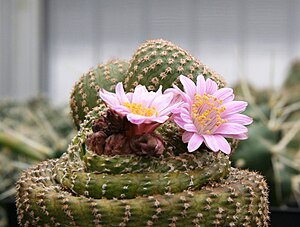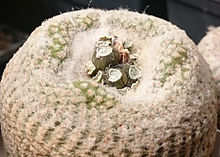Yavia cryptocarpa
| Yavia cryptocarpa | ||||||||||||
|---|---|---|---|---|---|---|---|---|---|---|---|---|

Yavia cryptocarpa |
||||||||||||
| Systematics | ||||||||||||
|
||||||||||||
| Scientific name of the genus | ||||||||||||
| Yavia | ||||||||||||
| R. Kiesling & Piltz | ||||||||||||
| Scientific name of the species | ||||||||||||
| Yavia cryptocarpa | ||||||||||||
| R. Kiesling & Piltz |
Yavia cryptocarpa is the only plant species of the monotypic genus Yavia in the cactus family(Cactaceae). The botanical name of the genus refers to the Argentine Department Yavi , where the holotype was found . The epithet of the species is derived from the Greek words "κρυπτος" for hidden and "καρπος" for fruit , means hidden fruit and refers to the fruits hidden by the wool felt in the vertex of the plants.
description
Yavia cryptocarpa , which usually grows individually, has a cylindrical to inverted cone-shaped, green plant body that is between 0.5 and 1.5 centimeters in height and 1.3 to 2.5 centimeters in diameter (rarely 3 centimeters). The upper part is flat, the apex is sunk 5 to 8 millimeters. The elongated areoles sit on tiny, less pronounced humps, which can also be missing. They are about 1 millimeter long and about 0.5 millimeters wide. From them arise 8 to 15 pink thorns , which become glassy-white with age.
The flowers are 10 millimeters long and 20 millimeters in diameter. The flower cup, which is up to 5 millimeters long and 2 millimeters wide, is bare. The perianth is conical. The outer, olive petals are spatulate, 4 millimeters long and 2.5 millimeters wide. The inner, lanceolate, 6 to 7 millimeters long and 3 to 4 millimeters wide petals are white to pink with a whitish edge.
The inverted conical, bare, small fruits are embedded in the apex depression and surrounded by the wool felt of the young areoles. They contain few, dark brown and more or less oval seeds .
Distribution, systematics and endangerment
Yavia cryptocarpa is widespread in the north of the Argentine province of Jujuy in the border area with Bolivia at altitudes of about 3700 meters.
The first specimens were discovered in February 1986 by Roberto Kiesling . However, the specimens collected at that time were lost. It was only in 2000 that new specimens could be collected and also cultivated. The first description , written together with Jörg Piltz , appeared in March 2001 in Kakteen und other Succulents , the magazine of the German Cactus Society .
In the Red List of Threatened Species of IUCN is the species as " Endangered (EN) ," d. H. listed as endangered.
proof
- Roberto Kiesling, Jörg Piltz: Yavia cryptocarpa R. Kiesling & Piltz, gen. & Spec. nov. In: Cacti and other succulents . Volume 52, No. 3, 2001, pp. 57-63.
- Edward F. Anderson : The Great Cactus Lexicon . Eugen Ulmer KG, Stuttgart 2005, ISBN 3-8001-4573-1 , p. 646 .
Individual evidence
- ↑ Yavia cryptocarpa in the IUCN Red List of Threatened Species 2013.2. Posted by: Kiesling, R. & Ortega-Baes, P., 2010. Retrieved January 10, 2014.
Web links
- R. Kiesling, O. Ferrari: Yavia cryptocarpa - conservation action on a new and interesting cactus In: British Cactus and Succulent Journal . Volume 21, number 1, pp. 20-25 ( PDF ( Memento from September 27, 2007 in the Internet Archive ))
